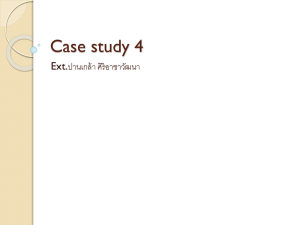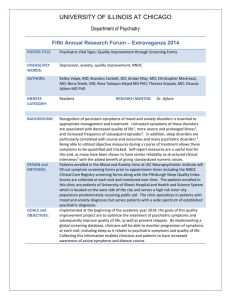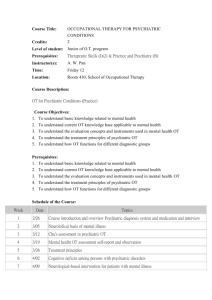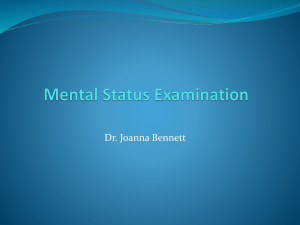Presentation - LSU Hospitals
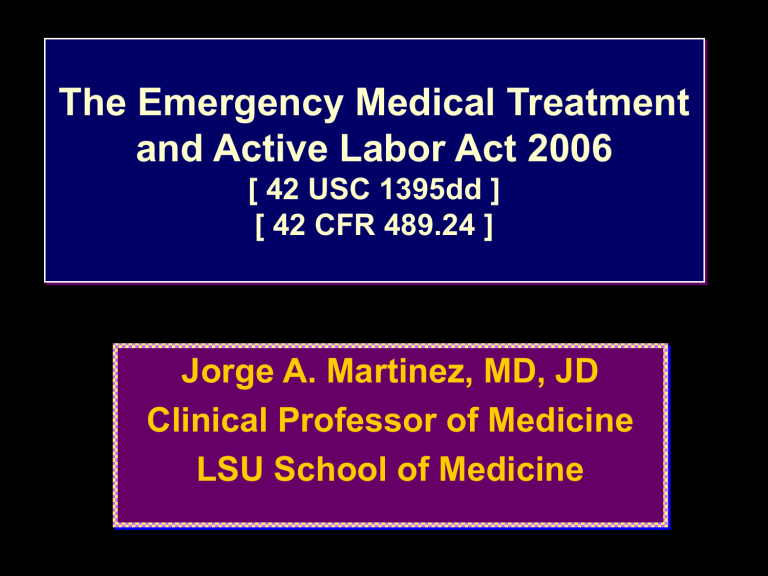
The Emergency Medical Treatment and Active Labor Act 2006
[ 42 USC 1395dd ]
[ 42 CFR 489.24 ]
Jorge A. Martinez, MD, JD
Clinical Professor of Medicine
LSU School of Medicine
EMTALA – Basic Scheme
42 US 1395 dd
Individual
“Comes to” emergency department
Appropriate medical screening examination
No Emergency Medical Condition
EMTALA obligations ends
Emergency Medical Condition exists
Stabilizing treatment
Transfer
Important Terms
Individual “comes to” the ED
Must perform MSE – includes ancillary services
Must determine if emergency medical condition exists
If EMC exists = must stabilize before transfer
“Comes to” the ED
42 CFR 489.24 (b)
• Has presented at hospital’s dedicated ED and requests examination or treatment or request is made on his behalf, or a prudent layperson would believe that the individual needs an examination
• Has presented on hospital property other than hospital’s dedicated ED and requests examination or treatment…
“Comes to” the ED
42 CFR 489.24 (b)
• If transported by am bulance owned and operated by the hospital … even if the ambulance is not on hospital grounds.
• This provision does not apply if the hospital-owned ambulance is operating under community wide EMS protocols that direct it to transport the individual to another hospital…
“Comes to” the ED
42 CFR 489.24 (b)
• Nonhospital-owned ambulance – if the individual arrives on hospital property for examination and treatment of a medical condition at the hospital’s dedicated ED…
Dedicated Emergency Department
42 CFR 489.24 (b)
1) Is licensed by the state as an emergency department
2) Is held out to the public (by name, advertising, posted signs, other means) as a place that provides care to emergency situations on an urgent basis without an appointment
3) During the previous year provided at least 1/3 of visits for emergency treatment without requiring a scheduled appointment
Hospital Property
Sec 413.65(a)
• Hospital property includes the entire hospital campus
• Encompasses any part of the hospital other than the dedicated emergency department
• Includes hospital departments, parking lot, sidewalk and driveway, and any buildings owned by the hospital that are within 250 yards of the hospital
Emergency Medical Condition
1395dd (e)
A medical condition with acute symptoms (including pain, psychiatric sx’s, or substance abuse) where the lack of immediate medical attention could reasonably be expected to:
1) Place health of individual or unborn child in serious jeopardy
2) Cause serious impairment of bodily function
3) Cause serious dysfunction of body organ/part
Caution!!
Some intoxicated individuals may meet the definition of “emergency medical condition”because the absence of medical treatment may place their health in serious jeopardy or result in serious dysfunction of a bodily organ.
Further, it is not unusual for intoxicated individuals to have unrecognized trauma.
Caution!!
Likewise, an individual expressing suicidal or homicidal thoughts or gestures, if determined dangerous to self or others, would be considered an “emergency medical condition.”
What is an Acceptable
Medical Screening?
CMS Interpretive Guidelines state the following;
• Individuals coming to the emergency room must be provided a medical screening beyond initial triage.
• The medical screening must be the same medical screening that the hospital would perform on any individual coming to the hospital’s emergency room with those signs and symptoms, regardless …………..to pay.
What is an Acceptable
Medical Screening?
• A medical screening examination is the process required to reach with reasonable clinical confidence, the point at which it can be determined whether a medical emergency does or does not exist.
• Depending upon the patient, this process will vary from only a brief H&P to a complex process involving ancillary studies and specialty consultations.
What is an Acceptable
Medical Screening?
• A medical screening is not an isolated event. It is an ongoing process.
• Hospital and Department medical staff should address, through policy and medical standards, how best to provide the screening.
• Medical Screenings are required to be documented.
• If it isn’t written down, it never happened!!
Medical Screening
Documentation
• Need to document why the patient is now stable enough to be transferred.
Is patient hemodynamically stable to the best of our capabilities?
Has psychiatric condition been evaluated and treated to the best of our capabilities?
Have any abnormal test (EKGs) been repeated if the first one was abnormal and the patient has been in our care for a lengthy period of time?
Caution!!
• Regardless of a positive or negative patient outcome, a hospital will be in violation of the anti-dumping statute if it fails to meet any of the medical screening requirements.
• If a misdiagnosis occurs, but the hospital utilized all of its resources, a violation of the screening requirement does not occur.
CAUTION!!!!!!
• Case history has not been kind to hospitals who utilized non-physician medical screeners even though by law it is allowed.
• TRAIGE IS NOT CONSIDERED TO BE A
MEDICAL SCREENING!!!!!
Stabilization
1395dd (e)
• No material deterioration of the condition, within reasonable medical probability, will result from or occur during the transfer of the individual
• Pregnant woman who is having contractions: To deliver the fetus and placenta
Transfer
1395dd (e)
• The movement (including the discharge) of an individual outside of the ED facilities at the direction of any person employed by or affiliated or
associated, directly or indirectly, with the hospital
• Does not include
– the movement of a dead body
– person who leaves AMA
Transfer
•
Rule
=
1395 dd (c)(1)
= Must stabilize before transfer
• Only exceptions to stabilize before transfer rule
1) patient requests (without coercion)
1395 dd (c)(1)(A)(i)
2) benefits of transfer outweigh risks of transfer 1395 dd (c)(1)(A)(ii)
3) MD refuses or fails to appear 1395 dd
(d)(1)(C)
Appropriate transfer
1395 dd (c) (B)
1) Before transfer to another hospital – must contact receiving hospital
2) Receiving hospital must accept patient before he/she can be transferred
3) Patient must be transferred by appropriate means (including personnel)
4) Receiving hospital must report transfer without approval to CMS
Transfer Documentation
• Must show that the transfer was initiated by either a written request by the patient (or his/her representative) or a physician’s certification.
• Must state the reason for the transfer.
• The receiving facility and the accepting physician. Recommendation: Include a brief statement that the patient’s full condition was discussed with the accepting physician.
• The risk and benefits of the transfer.
Transfer Documentation
Risk & Benefits!!
• Need to be realistic and pertinent to the case.
• MVA is not usually a true risk of the transfer that needs to be documented in most cases.
• Worsening of condition, lack of medical equipment, increase of pain, increase exposure to infection and no physician for intervention are some examples of true risk.
Delay in examination or treatment
42 CFR 489.24 (d)(4)
• Hospital may not delay providing MSE or medical examination and treatment to inquire of method of payment
• Hospital may not seek, or direct an individual to seek, authorization until after
MSE and medical examination and treatment has been initiated
Delay in examination or treatment
42 CFR 489.24 (d)(4)
• Hospitals may follow reasonable registration processes as long as it does not delay screening or treatment
– Registration processes may not discourage individuals from remaining for further evaluation
• Practitioner may contact individual’s physician to seek information or advise relevant to the medical treatment
Inpatients
42 CFR 489.24 (d)(2)
• If a hospital has screened an individual under paragraph (a), found to the individual to have an EMC, and admits the individual as an inpatient in good faith in order to stabilize the EMC, the hospital has satisfied its responsibilities
• Not applicable to individuals admitted on an elective/nonemergent basis
On-call physicians
42 CFR 489.24 (j)
• Each hospital must maintain MD on-call list that best meets the needs of its patients
• The hospital must have written policies and procedures that
– Respond to situations where a particular specialty is not available or the on-call MD cannot respond because of circumstances beyond MD’s control
– Assures emergency services are available if it elects to permit on-call physicians to schedule elective surgery when they are oncall or to permit simultaneous on-call duties
EMTALA and psych patients
• Psychiatric emergency medical condition
– patient is danger to self or others
– patient has potential to be danger to self or others
– substance abuse
• Psychiatric emergency medical condition is
stabilized when patient is no longer danger to self or others
EMTALA and psych patients
• Screening essentials
– Physician must screen for
• physical and mental illness
• history of violence to himself or others
• suicide attempt or voiced suicidal ideation
• danger to herself or others by making violent acts, gestures, or threats
• signs of confusion or mental status changes
• substance abuse that can affect the patient’s cognition or judgment
EMTALA and psych patients
• EMTALA does not require the patient to have laboratories or radiographies performed to ensure medical stability.
• It does require that psychiatric patients with medical problems are transferred to a psychiatric facility that is equipped to handle the patients’ medical problem
.
Moy, MM: EMTALA and Psychiatry in The EMTALA Answer Book
2nd Edition. Gaithersburg, MD:Aspen; 2000 www.uic.edu/com/ferne/slides/Boston0503/Evaluation%20of%20Psych%20Patients.pps
Short mental status examinations
• Mini-Mental State Exam
• The Brief Mental Status Examination
• Short Portable Mental Status
Questionnaire
• Cognitive Capacity Screening
Examination www.uic.edu/com/ferne/slides/Boston0503/Evaluation%20of%20Psych%20Patients.pps
Short mental status exams in the ED
• Used the Brief Mental Status Examination in an inner city ED.
• Score 0-8 normal, 9-19 mildly impaired,
20-28 severely impaired
• 100 randomly selected subjects
• 100 subjects with indications for the exam
• 72% sensitivity and 95% specificity in identifying impaired individuals in the ED
Kaufman, DM, and Zun, LS: A Quantifiable, brief mental status examination for emergency patients: J Emerg Med, 13:449-456,
1995.
www.uic.edu/com/ferne/slides/Boston0503/Evaluation%20of%20Psych%20Patients.pps
Questions:
Brief Mental Status Examination* www.uic.edu/com/ferne/slides/Boston0503/Evaluation%20of%20Psych%20Patients.pps
Score
(number of errors) x (weight) =
What year is it now?
0 or 1 x 4 =
What month is it?
0 or 1
Present memory phase after me and remember it:
John, Brown, 42, Market Street, New York
About what time is it?
(Answer correct if within 1 hour)
0 or 1
Count backwards from 20 to 1.
Say the months in reverse
Repeat the memory phase
(each underlined portion is worth 1 point) x 3 x 3 =
=
0.1. or 2 x2
0, 1, or 2 x2
0,1,2,3,4 or 5 x 2 =
=
=
Final score [equal to the sum of the total(s)] =
* Katzman, R, Brown, T, Fuld, P, Peck, A, Schechter, R, Schimmel, H: Validation of a short orientation-memory concentration test of cognitive impairment. Am J Psych 1983; 140:734-9.
Need laboratory studies
• 46% of psychiatric patients had unrecognized medical illness.
• Hall, RC, Gardner, ER, Popkin, MK, et. al: Unrecognized physical illness prompting psychiatric admission: A prospective study. Am J
Psych 1981; 138: 629-633.
• 92% of one or more previously undiagnosed physical diseases.
• Bunce, DF: Jones, R, Badger, LW, Jones, SE: Medical Illness in psychiatric patients: Barriers to diagnoses and treatment. South
Med J 1982: 75:941-944.
• 43% of psychiatric clinic patients had one or several physical illnesses.
• Koranyi, E: Morbidly and rate of undiagnosed physical illness in a psychiatric population. Arch Gen Psych 1979; 36: 414-419.
www.uic.edu/com/ferne/slides/Boston0503/Evaluation%20of%20Psych%20Patients.pps
Need laboratory studies
• Retrospective review of 158 patients, 6% of the psych patients had undiagnosed physical illness that might contribute to psychiatric illness.
• Skelcy, K, Wagner, MJ: Medical clearance of the psychiatric patient, ACEP
Research Forum, 2000.
www.uic.edu/com/ferne/slides/Boston0503/Evaluation%20of%20Psych%20Patients.pps
New onset psych presentation
• 100 consecutive patients aged 16-65 with new psychiatric symptoms
• 63 of 100 had organic etiology for their symptoms
– History (100) 53% ABN
– PE (100) 64% ABN
– CBC (98)
– SMA-7 (100)
– Drug
72% ABN
73% ABN
27% sign
6% sign
5% sign
10% sign screen (97)
– CT scan (82)
– LP (38)
37% ABN
28% ABN
55% ABN
29% sign
10% sign
8% sign
• Point : Patients may need extensive laboratory and radiographic evaluations including CT and LP
Hennenman, PL, Mendoza, R, Lewis, RJ: Prospective evaluation of emergency department medical clearance. Ann Emerg Med 1994;24:672-677 .
www.uic.edu/com/ferne/slides/Boston0503/Evaluation%20of%20Psych%20Patients.pps
Medical workup not necessary
• Most laboratories, EKG and radiographic testing should be abandoned in favor of a more clinically driven and cost effective process.
• Allen, MH, Currier, GW: Medical assessment in the psychiatric emergency service. New Directions in Mental Health Services
1999;82:21-28.
• Patients with primary psychiatric complaints with other negative findings do not need ancillary testing in the ED.
• Korn,CS, Currier, GW, Henderson, SO: “Medical Clearance” of psychiatric patients without medical complaints in the emergency department. J Emerg Med 2000;18:173-176.
www.uic.edu/com/ferne/slides/Boston0503/Evaluation%20of%20Psych%20Patients.pps
Medical workup not necessary
• Medical and substance abuse problems identified by initial vital signs along with a basic history and physical examination
• Olshaker, JS, Browne, B, Jerrard, DA, Prendergast, H, Stair, TO:
Medical clearance and screening of psychiatric patients in the emergency department. Acad Emerg Med 1997;4:124-128.
• Universal laboratory and toxicological screening are low yield
• Olshaker, JS, Browne, B, Jerrard, DA, Prendergast, H, Stair, TO:
Medical clearance and screening of psychiatric patients in the emergency department. Acad Emerg Med 1997;4:124-128 .
www.uic.edu/com/ferne/slides/Boston0503/Evaluation%20of%20Psych%20Patients.pps
Poor documentation of medical aspect of
Medical Screening Examination in psych patients
• 298 charts reviewed in 1991 at one hospital
• Triage deficiencies
– Mental status 56%
• Physician deficiencies
– Cranial nerves 45%
– Motor function
– Extremities
– Mental status
38%
27%
20%
• “Medically clear” documented in 80%
Tintinalli, JE, Peacodk, FW, Wright, MA: Emergency medical evaluation of psychiatric patients. Ann Emerg Med 1994; 23:859-862.
www.uic.edu/com/ferne/slides/Boston0503/Evaluation%20of%20Psych%20Patients.pps
“Medically Clear”
• “Medically stable” vs “medically clear”
• Both terms have great capacity to mislead
– Concern about misdiagnosis, premature referral, and misunderstandings
• Better to write Discharge Note
– History and physical examination
– Mental status and neurologic exam
– Laboratory results
– Treatment plan
– Transfer/discharge instructions
– Follow up plans
Weissberg, M: Emergency room clearance: An educational problem.
Am J Psych 1979;136:787-789 .
www.uic.edu/com/ferne/slides/Boston0503/Evaluation%20of%20Psych%20Patients.pps
Patient’s name _______
Date _________________
Medical Clearance Checklist
Race ______________
Date of birth________
Gender ________________ Institution _____________
1. Does the patient have new psychiatric condition?
Yes
No
2. Any history of active medical illness needing evaluation?
3. Any abnormal vital signs prior to transfer
Temperature >101 o F
Pulse outside of 50 to 120 beats/min
__
__
__
__
Blood pressure<90 systolic or>200;>120 diastolic
4. Any abnormal physical exam (unclothed) a. Absence of significant part of body, eg, limb b. Acute and chronic trauma (including signs of abuse) c. Breath sounds
__
Respiratory rate >24 breaths/min __ __
(For a pediatric patient, vital signs indices outside the normal range for his/her age and sex)
__
__
__
__
__ d. Cardiac dysrhythmia, murmurs e. Skin and vascular: diaphoresis, pallor, cyanosis, edema f.
Abdominal distention, bowel sounds
__
__
__
___
__
__
__
___ www.uic.edu/com/ferne/slides/Boston0503/Evaluation%20of%20Psych%20Patients.pps
g. Neurological with particular focus on: i. Ataxia ____ ii. pupil symmetry, size ___ iii. Nystagmus ___ iv. Paralysis ___ v. meningeal signs ___ vi. Reflexes ___
5. Any abnormal mental status indicating medical illness such as lethargic, stuporous, comatose, spontaneously fluctuating mental status? _____
If no to all of the above questions, no further evaluation is necessary. Go to question #9
If yes to any of the above questions go to question #6, tests may be indicated.
6. Were any labs done?
What lab tests were performed? ________________________________
What were the results?
Possibility of pregnancy ?
________________________________
What were the results?
________________________________
7. Were X-rays performed?
What kind of x-rays performed? _________________________________
What were the results? ________________________________________
8. Was there any medical treatment needed by the patient prior to medical clearance?
What treatment? ________________________________________________ www.uic.edu/com/ferne/slides/Boston0503/Evaluation%20of%20Psych%20Patients.pps
9. Has the patient been medically cleared in the ED?
_________
10. Any acute medical condition that was adequately treated in the emergency department that allows transfer to a state operated psychiatric facility (SOF)?
What treatment? _________________________________________
11. Current medications and last administered?
_____________________________________________________________
_____________________________________________________________
12. Diagnoses : *Psychiatric________________________________________
*Medical____________________________________________________
*Substance abuse____________________________________________
13. Medical follow-up or treatment required on psych floor or at SOF?
___________________________________________________________
14. I have had adequate time to evaluate the patient and the patient’s medical condition is sufficiently stable that transfer to ___SOF or ___ psych floor does not pose a significant risk of deterioration. (check one)
____________________________________MD/DO
Physician Signature www.uic.edu/com/ferne/slides/Boston0503/Evaluation%20of%20Psych%20Patients.pps
Case
A local law enforcement agency presents to the ER with a subject whom they have arrested. They request a psychiatric evaluation on the subject. The hospital is on psychiatric diversion due to no beds.
The triage nurse advises the law officers of this and they voluntarily take the subject to another hospital.
Is this a violation of EMTALA?
EMTALA Violation?
Answer --- YES
Why ?
The patient was present on hospital grounds and a request for services was made. At a minimum, the patient should have had a medical screening completed and documented. If the law officers voluntarily decide to leave without a medical screening, it should be documented with the appropriate details that the patient left without being seen.
Rules of Thumb
Never turn a patient away once they are on hospital property.
Always perform an appropriate medical screening if the patient (or representative) is requesting medical services.
Document Everything!!
Make Sure You Document Everything!!
Document, document, document!!!!!

